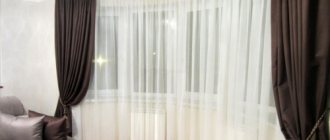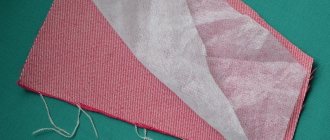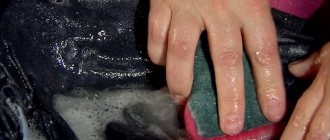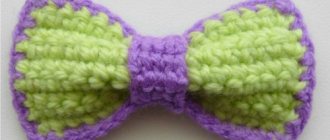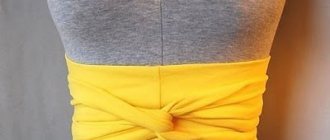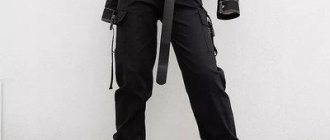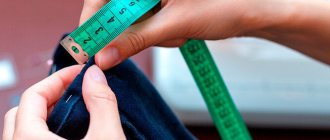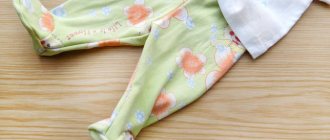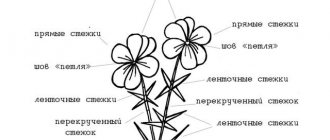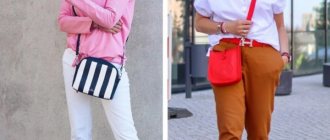Processing the bottom of men's trousers is done by sewing a special braid along the bottom of the trousers. This is the only correct way to handle the hem of the trousers. Trouser tape or trouser braid, first of all, protects the fabric of trousers from abrasion, and secondly, gives rigidity to the lower part of men's trousers. Women's trousers do not use braid.
In this video you will learn how to hem men's trousers with trouser tape on a sewing machine. The hem of the trousers is secured with a hidden hand stitch.
The hem with stitched braid is sewn with a blind seam manually or on a special sewing hemming machine, which is used only in the atelier. Processing the bottom of the trousers with adhesive tape (cobweb) is short-lived and after several washes you still have to hem the trousers with thread.
How to properly hem trousers on a sewing machine using trouser tape. The master class is based on a training sample that imitates a trouser leg. Contrasting threads are used for clarity.
What types of tapes are used for hemming trousers?
Slim, straight, flared trousers look elegant if the hem is finished with a special trouser hem tape. With its help, the bottom of the product is protected from abrasion and deformation. Buy braid by the meter in the sewing accessories department.
Braid or grosgrain ribbon
For high-quality processing of the bottom of the trousers, trouser braid is used. This is a textile product made of cotton and polyester of increased strength. The width of the tape is 15 mm, there is a slight thickening along one edge.
Comment! Rep tape (braid) is applied to the bottom of trousers made from medium and thick materials.
Processing the hem of the bottom of the trouser legs with braid increases the wear resistance of the product. It protects the edge from wear. The braid is sewn on by machine, the connection is strong, so it is not afraid of repeated washing (hand, machine). Trouser braid lasts for many years. It doesn't fade or wear out. Advantages of finishing the bottom of the product with tape:
- strength;
- durability;
- resistance to deformation.
Spider web tape (with adhesive base)
Hot-melt adhesive tapes for hemming fabrics are made of polyamide. This is a strong adhesive connection. It can withstand light hand washing. To hem the bottom of the trousers, use adhesive tape (double-sided). It is produced in two colors (white and black) of different widths: 10, 15, 20 mm. Glue it using a hot iron and steam.
For heavy suiting fabrics, hot-melt mesh is produced. This is a type of cobweb, but tougher. It has a paper base on one side. After gluing (ironing), the paper layer is removed, an allowance is applied and heat treatment is carried out.
In what cases is it necessary to glue fabrics rather than stitching?
Adhesive materials are used in cases where it is necessary to fasten textile parts without seams. Also, the need for gluing fabrics often arises when sewing, repairing clothes, creating crafts and toys, applying stripes, appliqués and decorations to fabric, performing work using patchwork, quilting, decoupage, and scrapbooking techniques. Adhesive materials are indispensable when joining parts made of difficult-to-process, thin and loose fabrics. They are often used to hem the hems of trousers and skirts, and are especially appreciated by those who sew infrequently.
Gluing two layers of fabric together using adhesive tapes and webs is often used when sewing clothes, especially shirts, jackets and coats. These materials are used as cushioning, which allows increasing the density and rigidity of individual parts - necklines, trims, collars, cuffs, armholes. They also fix and protect seams and cuts from stretch marks, which is especially important when processing knitwear and other elastic materials. Thanks to this, sewn items become more durable and retain their shape better when washed.
How to hem men's trousers with braid?
Classic models of men's trousers are made from dense materials. To finish the bottom, a special braid is used, it is called differently (trouser, grosgrain). The name does not play a special role. There are certain rules for how to hem trousers using such tape.
How to try on pants
Long pants need to be cut. Before doing this, determine their length. The fitting is carried out with or without shoes. Be sure to wear a belt if trousers will be worn with it. When a person is wearing shoes, the bottom of the trouser leg falls in the middle of the heel.
When trying on without shoes, their bottom edge is at floor level. Using this rule, the correct length is determined. They fix it. To do this, at the desired level, the trouser legs are turned to the front side, and each fold is secured with pins in the area of the crotch and side seam.
Steps to prepare the bottom of the trousers to sew on the tape
The product is turned right side out. Using a centimeter, measure the distance from the waistband to the fold of one trouser leg. Make a mark with chalk. The same distance is measured on the second leg. From a mark perpendicular to the side seam, draw a line with chalk, first on one half of the trouser leg, then on the second.
This line determines the length of the trousers. The operation is repeated with the second leg. Using a centimeter, measure the distance from the waist to the line along the side and crotch seam. They should match on both legs.
Step back 4 cm from the bottom line and make a mark. This is the allowance size. If the length of the product is not enough, then leave 2-3 cm for the hem. From the mark perpendicular to the side seam, draw a cutting line on both legs. Fold the trousers in half. Check the accuracy of the markings. Trim off excess length.
Materials for filing
In order to properly process the bottom of the trousers, the grosgrain tape is given the same shade as the trouser fabric. Before making a purchase, measure the width of the trousers (S) along the bottom line. Do the calculation:
- length of grosgrain tape for processing one trouser leg L = S + 3 cm;
- total consumption for both legs R = L * 2.
Important! Before use, the grosgrain ribbon must be soaked in hot water and dried. After this treatment, it will not change size after washing the product.
To work you will need threads: contrasting ones - for stitching, matching threads - for hemming. You will need a sewing machine, sewing needles and pins for chopping fabric, and scissors. To apply markings you will need:
- chalk;
- tape measure (centimeter);
- square
Process description
The edge of the trouser legs is processed using an overlocker or a zigzag stitch on a machine. The trousers are turned right side out. To hem correctly, the braid is laid on the trouser leg with the thickening pointing up. Its end edge should extend 1.5 cm beyond the crotch seam.
To prevent the tape from moving out during basting, it is pinned along its entire length to the fabric of the trousers with pins. Make sure that the edge of the thickening on the braid falls on the bottom line. Using a needle and thread of a contrasting color, the braid is hemmed. The line is placed in the middle.
In the area of the crotch seam, the remaining end of the braid is folded. Its fold is placed on the crotch seam and basted. Adjust the tape on the machine in 2 lines:
- the first is laid next to the thickening on the braid;
- The second machine line is sewn on the opposite side, stitched to the edge.
Advice! A high-quality seam is made using a zipper foot.
Another seam is laid at the junction of the braid. The pant leg allowances are turned inside out and basted. Make sure that 2-3 mm of the tape protrudes from under the bottom of the trouser legs. Finish the processing of the trouser legs by hemming the hem in one of the following ways:
- sew by hand with a blind seam;
- sew on a machine if it has a “blind stitch” function;
- Fold up the trouser seam allowance using adhesive tape.
How to tape the hem of men's trousers with adhesive tape
Measure out the adhesive tape. Place it between the bottom of the trouser leg and the seam allowance. Make sure that it lies along the edge of the allowance, but does not protrude due to the fabric. Heat the iron and run it along the bottom of the trouser leg. The adhesive tape melts under the influence of temperature and steam, firmly fixing the hem.
Hemming a product using a web has advantages compared to hand and machine seams:
- nothing is visible on the front side;
- The pants are hemmed quickly.
Housewife tricks
- To accurately determine the length, the model must be completely still. This is impossible if you are the model yourself. Turning to help from family members or friends is inevitable.
- If it is impossible to attract outside observers or if the model is not physically nearby, take the most successfully hemmed trousers and shorten the new ones, focusing on the length of the old ones.
- Gossamer is not as reliable as hemming by hand, although it does give a smooth, beautiful edge to the product . Many people glue the tape, and for reliability they also hem the bottom.
- If the store doesn’t have a ribbon of the right color, take another one - it’s not a problem for tight trousers, any color will suit them. It won't be on the surface. But thin summer ones, especially light ones, will require more attention. They require a white web, but it is found in stores more often than other colors.
- There is only a narrow adhesive tape available - no problem, take twice as much of it and glue it in two rows, placing them next to each other.
- The length of the trousers can be easily determined with an iron. To do this, determine the length on the model by bending the trouser leg up inside out and securing it at the back with one pin. We take off the pants and lay them out on the ironing board. By matching the side seams, we reach the even desired length line along the entire circumference. We smooth it with an iron and remove the pin. That's it, the line is drawn. Next, we cut off the excess, turn the trousers inside out and glue the tape.
What to wear with a blue down jacket
How to tie a men's neckerchief?
How to shorten trousers using web tape?
When there are children in the family, it is very convenient to have a tape for hemming trousers with an iron. They grow quickly and you need to constantly lengthen old pants or shorten new ones. With the help of a web, it is easy to shorten women's trousers made of light fabric.
The operation does not take much time. They do a fitting. How to do this is described above. If the trousers are shortened, then the trouser legs are not rolled up at the floor, but at the required height and pinned together.
Turn them right side out. Lay out on a flat surface. In the place where the fabric is pinned, place a mark with chalk. A bottom line is drawn perpendicular to the crotch seam. To bend, 1.5-2 cm are removed from it, and a cutting line is drawn using a ruler.
Compare the markings of both trouser legs. If the marks are placed correctly, cut off the excess fabric. If the fabric frays, the edge is processed with an overlocker or a zigzag seam on a machine. Perform sequential actions:
- The allowance along the bottom line is turned to the wrong side.
- Pinned with pins.
- Iron it.
- Measure out the required amount of web.
- Carefully place the tape under the edge of the hem.
- Pin it to the fabric to prevent it from slipping.
- Pass a hot iron along the bottom of the legs so that the adhesive tape melts.
Some useful tips
- Practical use shows that the web can come off after several washes. In this case, you just need to do the above processes again. This must be taken into account and, if possible, apply adhesive tape to products that are less susceptible to washing and have less contact with water.
- When washing items with cobwebs, avoid high temperatures.
- There are unpleasant situations when, during the ironing process, the adhesive composition remains on the iron. A small piece of cloth soaked in an alcohol solution will come in handy here. It removes glue residue perfectly. To avoid staining the iron, it is recommended to use a thin cloth or gauze. This way, the iron will be protected and will not have to be cleaned.
The web is very easy to use and is an indispensable material. We hope that this article will help you properly shorten your pants in a simple and convenient way.
Pattern of a kimono robe with wrap and sleeves
Knitting patterns for women's jumpers
Features of hemming trousers with adhesive tape
The tape is not used if the product is subject to frequent washing. It is not suitable for expensive and heavy fabrics. It is convenient to use for adjusting children's clothing. And also hem models for adults if their length often changes. This problem happens to women when they wear shoes with different heel heights.
The web is used by mothers of fast-growing teenagers. When shortening the pants, they leave a large allowance. When they become short, the seam allowance is peeled off and the trouser legs are lengthened. Classic models of women's and men's trousers are hemmed using tape.
Some features of using gossamer to shorten a product:
- You can’t place the web directly on the fold, you need to step back 5 mm from it;
- wash the product at 60 °C;
- if a wide tape is glued (more than 10 mm), the edge of the product looks rough.
Processing a cut of trouser leg fabric
If you have an overlocker at home, then, of course, it is best to overcast the cut of the trouser leg fabric. If you don’t have an overlocker, then you can use a zigzag stitch, or it is much better, in combination with a special foot, to choose an overlock stitch that imitates an overlock stitch.
It’s good if your sewing machine has the ability to detach or fold the working surface (table). Without a table, it is much more convenient to attach the trouser tape along the narrow leg of the trousers.
Using fabric glue: types, composition and method of application
You can glue the fabric not only with adhesive web or tape, but also with a special textile glue that does not leave marks. Manufacturers offer a wide range of adhesive materials with different compositions. The selection of glue should be carried out taking into account the type of fabric and the conditions in which the finished product will be used, therefore, before use, be sure to read the information on the packaging.
Rubber based adhesive
Rubber-based adhesive is a solution of rubber or its mixtures and synthetic resin in a solvent. It has great elasticity and resistance to low and high temperatures. Suitable for working with thick fabrics, bonds fabric and leather well. After application, the adhesive based on natural rubber remains in a liquid state for several hours, so it is suitable for joining large parts - you can straighten the fabric and smooth out folds at any time. It is applied to the fabric, allowed to dry a little, another layer of fabric or part is applied and pressed.
Perchlorovinyl glue
Perchlorovinyl adhesive is a solution of perchlorovinyl resin in organic solvents. It is moisture resistant, resistant to oils and gasoline. Suitable for gluing materials of different compositions - fabrics, leather, rubber. Operating temperature range – from -20 to +100 degrees. Widely used in the shoe industry. The glue is applied in 2 layers with a break of 10 minutes, then the surfaces to be glued are pressed and left under load for 2 days.
Transparent glue in the form of a liquid thread
Glue in the form of a liquid thread is capable of quickly gluing various materials together, so it is widely used for creating appliques, gluing decor, stripes, and lace. The glue is applied evenly in a thin layer to the surface of the fabric, after a minute the part requiring fixation is applied and pressed firmly for 10–15 seconds. If thick fabric is glued, it is additionally ironed.
Nitrocellulose glue
Nitrocellulose glue is a solution of nitrocellulose in organic solvents. Has increased flammability. It provides a tight connection that is not afraid of moisture, sunlight, and detergents. It is highly effective at gluing fabrics and leather, so it is often used in the manufacture of shoes. The composition is applied to both surfaces, which are immediately connected and placed under the load.
Polyvinyl acetate glue
PVA is a non-toxic universal glue, suitable for gluing many materials, including fabrics. The stationery option is not used for textiles. The varieties that work best with materials are “SuperPVA” and PVA-MB (universal). The glue is water-soluble, so if the product is going to be wet and washed, it is better to refuse in favor of another, water-resistant one.
Homemade adhesive composition
The adhesive composition can be prepared at home:
Dextrin
- Dextrin glue. At 2 tbsp. l. dextrin take 5 tbsp. l. cold water and heated until warm, after which 1 tbsp is added to the mixture. l. glycerin. The composition can be prepared from starch, but it will take longer. The powder is placed in a porcelain or enamel bowl and placed in the oven for 2 hours, setting the temperature to 160°C. After this time, the starch will turn into dextrin, from which glue is prepared in the manner described above.
- Casein glue. The main component is milk protein casein. You can prepare a composition based on it as follows: place 1 part of casein powder in a container and add 2 parts of water, pouring it in a thin stream and mixing thoroughly. The glue must be used within 1–2 hours. It is not afraid of moisture and adheres well to fabric, wood, leather, and ceramics.
What is it and where is it used
Gossamer is a material consisting of thin adhesive fibers that are connected by weaving. The width of the roll ranges from 0.5 cm to 5 cm. A roll 90 cm wide is available for sale.
- There is no time to go to the sewing workshop, but the item is urgently needed.
- Sewing stitches on thin fabric are unacceptable.
- Gluing collars, cuffs, hemming trousers.
- The fabric contains a cut that requires immediate repair.
- Sealing the corners of the product.
The use of a mesh is acceptable if the clothes do not require frequent washing and there is no constant contact with hot water.
There are two types of material:
- On a paper basis - a diamond-shaped mesh, more flexible and stretchable.
- Cobweb without paper, in rolls - dry glue in a strip.
